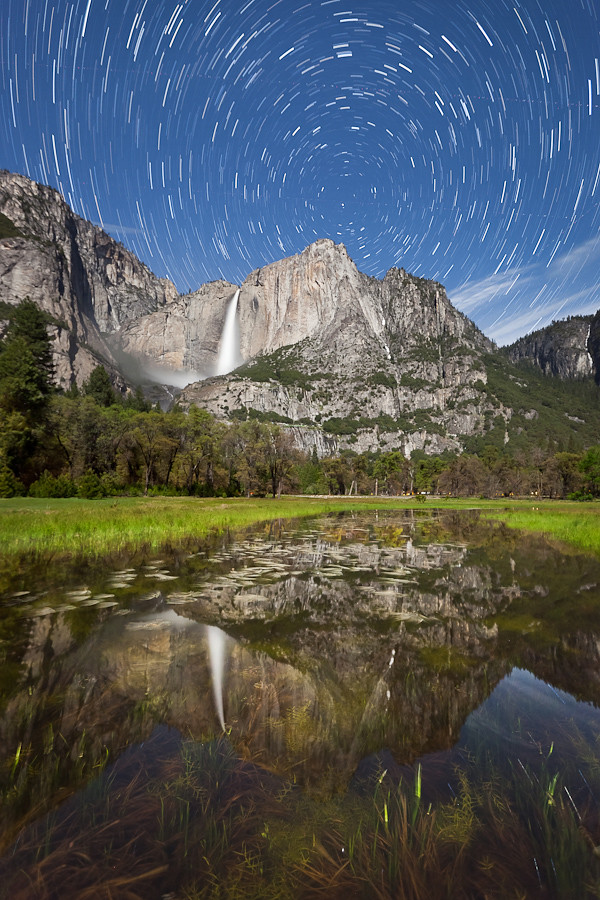
The Basics
With today's digital cameras it is surprisingly easy to create star trails images. At the highest level, all you do is run a sequence of night star shots through a star trails program and enjoy the result. As is often the case, the challenges come in the details.
 You'll need to capture images covering 30 to 60 minutes or more. A sturdy tripod is essential. You can trigger exposures manually, but that's tedious and not fun to do for an hour at night. Ideally you'll have a remote trigger that can lock down to fire off sequential shots, or even better, an intervalometer which takes shots at certain intervals which you define.
You'll need to capture images covering 30 to 60 minutes or more. A sturdy tripod is essential. You can trigger exposures manually, but that's tedious and not fun to do for an hour at night. Ideally you'll have a remote trigger that can lock down to fire off sequential shots, or even better, an intervalometer which takes shots at certain intervals which you define.You'll need to focus your lens on an object at close to infinity, and leave the focus mode set to manual so it won't hunt for focus in the dark. The focus ring of your lens probably continues past that point to compensate for differences as temperatures fluctuate, so focus during daylight on a distant object and note where this is, or if your lens has continuous focus ring with no visible scale, focus your camera during the day, switch it into manual, and carefully tape the focus ring with removable painter's masking tape or gaffer's tape.
You'll want to take sequential shots close together so the star trails to be continuous, so turn off your camera's long exposure noise reduction.
You'll also want a consistent exposure, so use your camera in Manual exposure mode. Cameras have slightly different sensitivity to light, and the moon brightness (phase) and local light pollution can affect your exposure from night to night, so you'll need to run some tests to determine what settings to use for your individual shots.
 |
| Full moon exposure: 15 seconds f/4, ISO 3200 |
Once you have the basic exposure figured out, take that exposure over and over until you reach 30 to 45 minutes or more total. Leave as little time as possible between shots.
For this example I used about 80 shots of 30 seconds each, covering 40 minutes. I used the free StarStaX software (www.StarStaX.net) in "lighten" mode, where the lightest pixels are kept as images are merged, creating the trails as the stars move from frame to frame.
Intermediate Considerations
In very long exposures, digital camera sensors can produce random spots of bright single pixels referred to as "hot pixels". If you're shooting on a relatively warm night, about 60 to 70 degrees or warmer, with many cameras you may start to see more hot pixels the warmer it gets. StarStax can help you eliminate them. At the end of your star trails sequence, put your lens cap on and take a few more images of the all-black capped lens at the same settings you've been using. The only data in the image should be the hot pixels. StarStaX allows you to identify these images so it can automatically eliminate those hot pixels.
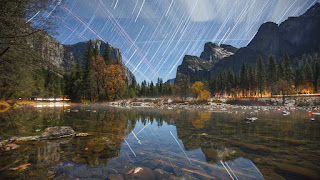 |
| Yosemite is under a major flight path for airplanes |
When editing airplane trails out of a starry sky, it is easiest to edit out short ones. Local light pollution on your foreground, or on a distant road, can be quickly and easily taken out as described below, provided that you have enough exposures to provide images with those areas not polluted with lights.
Advanced Considerations
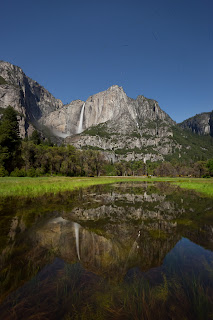 |
| Darken mode |
This also eliminates the star trails, but by using layers in Photoshop and blending that center portion of the darkened sequence into the lightened star trails sequence to get a star trails image without the car lights.
Once you decide to use separate images, you might question whether or not to use 30 second exposures, since that tends to also require high ISO, which many photographers associate with noise, or and very wide apertures, which many photographers associate with lower depth of field and/or softness in focus. These are valid considerations and if you have an intervalometer that can handle multiple minute exposures, there's no harm in testing different approaches. But the image stacking process in StarStaX eliminates most noise, so ISO isn't as much of a concern as many photographers tend to assume (at least not for noise).
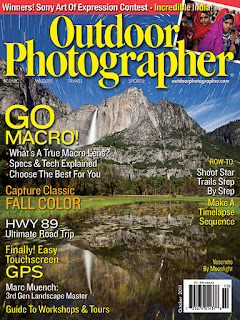 |
| One sequence of 30-second images |
On some external intervalometers I can lock the shutter release button down to have zero seconds between shots if the camera is set to continuous shooting mode, but there are two new variables introduced, the shooting mode and the intervalometer's features, which will eventually cause problems on a different combinations camera and intervalometer. Keep it simple, or pursue every last setting for ultimate quality if you wish, but understand that increasing complexity will increase your failure rate. Time and travel expenses are often the most valuable commodities for a landscape photographer, and long exposures and our desire to sleep make night shooting time even more precious. How many opportunities do you want to miss, when your itinerary doesn't allow staying an extra night to re-take a shot?
There are other subtle considerations on the capture, post-processing, and output/printing portions of the process, but this will get you off to a great start.
So start simple, and gradually try more ambitious shots or more complicated techniques as you like, but go give star trails a try!
---
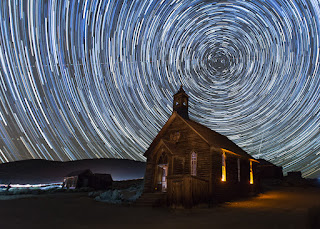 |
| Join us to learn night photography in Bodie! |
In many cases I offer a visit to Bodie adjacent to one of those longer workshops, so you can shoot in Bodie to start or end your trip.
If you're looking for dark places to try night photography on your own, consider anywhere away from metropolitan areas. I identify over 300 great locations for landscape photography in my new 320-page book, "Photographing California Vol. 2 - South", pictured below.
For night photography in California, focus on locations in the Southern California desert from Anza-Borrego State Park through Joshua Tree National Park and Mojave Preserve to Death Valley National Park, or on the Eastern Sierra region.
 |
| I offer author-signed copies on my Web site: www.JeffSullivanPhotography.com |
Great post, Jeff! Thanks, I'll have to download StarStax and give it a try...
ReplyDeleteNice trick, thanks. I'm excited to try this. :)
ReplyDeleteOnly problem I see is no star trails reflected in the water...
ReplyDeleteEvery time you look at water do you see reflections? No. It's not a problem, it's just the result of physics, based on the angle of incidence and other factors. Looking straight down in water mostly provides a view straight into the water (as you see here). Even at a much flatter angle of incidence when the water surface reflects much more of the light, the reflection is about 8X less bright than the direct view of an object, that's why photographers often use a 3 stop GND filter to balance out the direct and reflected images. There are a few of the brighter stars reflecting in the lower right corner, but the more dim ones get diffused by slight movement in the water's surface during 30 second exposures, so they don't show up. Combine all these factors, and you get exactly what you see here.
Delete